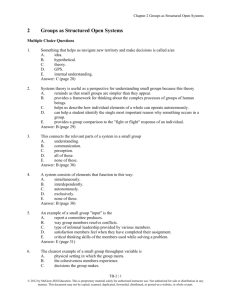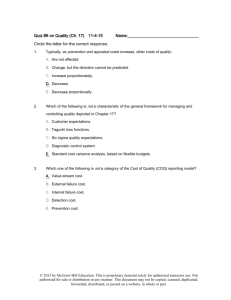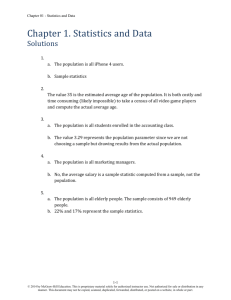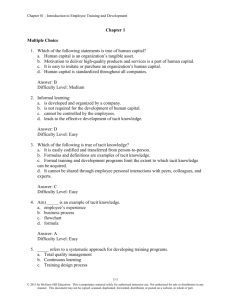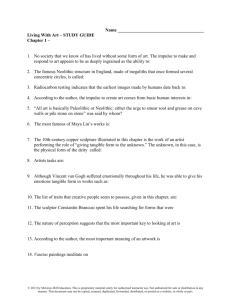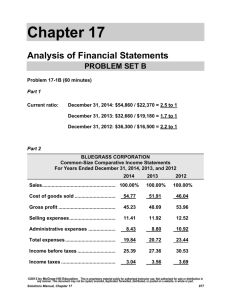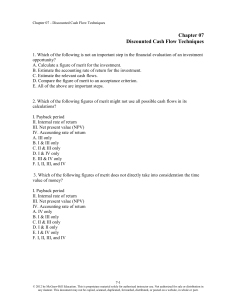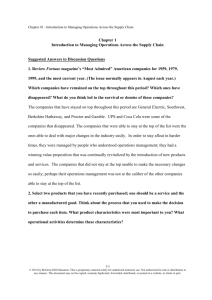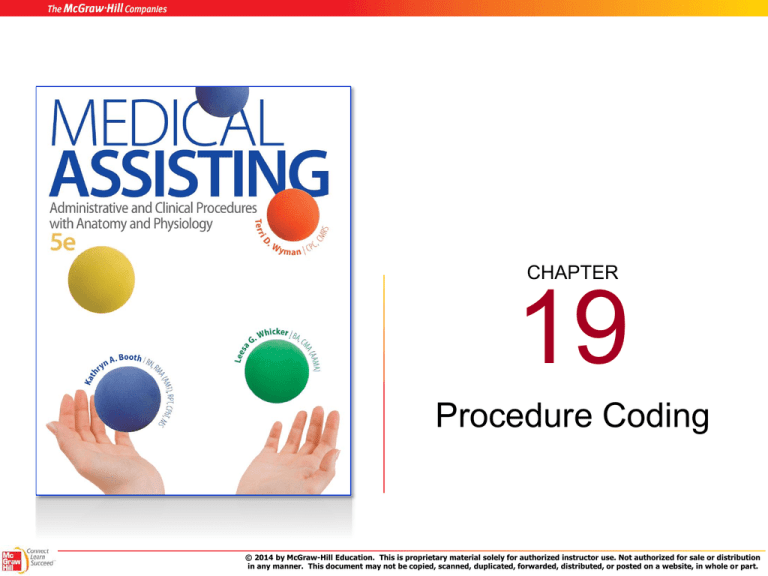
CHAPTER
19
Procedure Coding
© 2014 by McGraw-Hill Education. This is proprietary material solely for authorized instructor use. Not authorized for sale or distribution
in any manner. This document may not be copied, scanned, duplicated, forwarded, distributed, or posted on a website, in whole or part.
19-2
Learning Outcomes (cont.)
19.1 List the sections of the CPT manual, giving
the code range for each.
19.2 Describe briefly each of the CPT’s general
guidelines.
19.3 List the types of E/M Codes within the CPT.
19.4 List the areas included in the Surgical
Coding Section.
© 2014 by McGraw-Hill Education. This is proprietary material solely for authorized instructor use. Not authorized for sale or distribution
in any manner. This document may not be copied, scanned, duplicated, forwarded, distributed, or posted on a website, in whole or part.
19-3
Learning Outcomes (cont.)
19.5 Locate a CPT code using the CPT manual.
19.6 Explain how to locate a HCPCS code using
the HCPCS coding manual
19.7 Explain the importance of code linkage in
avoiding coding fraud
© 2014 by McGraw-Hill Education. This is proprietary material solely for authorized instructor use. Not authorized for sale or distribution
in any manner. This document may not be copied, scanned, duplicated, forwarded, distributed, or posted on a website, in whole or part.
19-4
Introduction
• Procedural coding
– Translate medical procedures and services
into codes
– Explains what services were provided
• Code “linkage” with diagnostic codes
• Maximum reimbursement
© 2014 by McGraw-Hill Education. This is proprietary material solely for authorized instructor use. Not authorized for sale or distribution
in any manner. This document may not be copied, scanned, duplicated, forwarded, distributed, or posted on a website, in whole or part.
19-5
The CPT Manual
• Procedure code
•
•
Medical procedures and services
Based on encounter form or patient record
• Current Procedural Terminology (CPT)
– HIPAA-required code set
– Published by the AMA
– Updated annually
– Use the appropriate CPT based on date of service
© 2014 by McGraw-Hill Education. This is proprietary material solely for authorized instructor use. Not authorized for sale or distribution
in any manner. This document may not be copied, scanned, duplicated, forwarded, distributed, or posted on a website, in whole or part.
19-6
Organization of the CPT Manual
Section
Range of Codes
Evaluation and Management
99201 – 99499
Anesthesiology
00100 – 01999
99100 – 99140
Surgery
10021 – 69990
Radiology
70010 – 79999
Pathology and Laboratory
80048 – 89356
Medicine
90281 – 99602
99500 – 99602
© 2014 by McGraw-Hill Education. This is proprietary material solely for authorized instructor use. Not authorized for sale or distribution
in any manner. This document may not be copied, scanned, duplicated, forwarded, distributed, or posted on a website, in whole or part.
19-7
Organization of the CPT Manual (cont.)
• Manual Introduction
– General instructions
– Information about common
• Prefixes
• Suffixes
• Word roots
• Guidelines for each section
© 2014 by McGraw-Hill Education. This is proprietary material solely for authorized instructor use. Not authorized for sale or distribution
in any manner. This document may not be copied, scanned, duplicated, forwarded, distributed, or posted on a website, in whole or part.
19-8
Organization of the CPT Manual (cont.)
• Sections
• Page
– Guidelines at
beginning
– Categories
headings
– Section name
– Subsection name
– Subheading
– Category
© 2014 by McGraw-Hill Education. This is proprietary material solely for authorized instructor use. Not authorized for sale or distribution
in any manner. This document may not be copied, scanned, duplicated, forwarded, distributed, or posted on a website, in whole or part.
19-9
Apply Your Knowledge
Match CPT section to number range
ANSWER:
70010-79999
Evaluation and management
Anesthesiology
00100-01999
99100-99140
99201-99499
Surgery
90281-99199
99500-99602
Radiology
80048-89356
10021-69990
Pathology and Laboratory
Medicine (except for Anesthesia)
© 2014 by McGraw-Hill Education. This is proprietary material solely for authorized instructor use. Not authorized for sale or distribution
in any manner. This document may not be copied, scanned, duplicated, forwarded, distributed, or posted on a website, in whole or part.
19-10
General CPT Guidelines
• Code format
• Add-on codes
– 5-digit numeric code
– Stand-alone unless
description contains a
semicolon
– Additional procedures
– Indicated by plus sign
(+)
– Indented codes
25500 Closed treatment of radial shaft
fracture; without manipulation
25505 with manipulation
© 2014 by McGraw-Hill Education. This is proprietary material solely for authorized instructor use. Not authorized for sale or distribution
in any manner. This document may not be copied, scanned, duplicated, forwarded, distributed, or posted on a website, in whole or part.
19-11
Symbols Used in CPT
Code description has been revised
A new code
# Codes are out of numeric sequence
New or revised text information
© 2014 by McGraw-Hill Education. This is proprietary material solely for authorized instructor use. Not authorized for sale or distribution
in any manner. This document may not be copied, scanned, duplicated, forwarded, distributed, or posted on a website, in whole or part.
19-12
Symbols Used in CPT (cont.)
Does not require modifier of 51
FDA approval pending
Moderate (conscious) sedation is
included in the procedure
© 2014 by McGraw-Hill Education. This is proprietary material solely for authorized instructor use. Not authorized for sale or distribution
in any manner. This document may not be copied, scanned, duplicated, forwarded, distributed, or posted on a website, in whole or part.
19-13
Organization of the CPT Manual (cont.)
• Modifiers
– Up to three per procedure
– Indicate that special circumstance applies
– Appendix A
– Section guidelines
© 2014 by McGraw-Hill Education. This is proprietary material solely for authorized instructor use. Not authorized for sale or distribution
in any manner. This document may not be copied, scanned, duplicated, forwarded, distributed, or posted on a website, in whole or part.
19-14
Category II, III, And Unlisted Procedure
Codes
• Category II – supplemental tracking codes
• Category III – temporary codes
• Unlisted codes
– code not yet assigned
– Include a description of service or procedure
– Check with payers regarding use
© 2014 by McGraw-Hill Education. This is proprietary material solely for authorized instructor use. Not authorized for sale or distribution
in any manner. This document may not be copied, scanned, duplicated, forwarded, distributed, or posted on a website, in whole or part.
19-15
Coding Terminology
• Bundled codes
– Read description
carefully
– Do not unbundle
• Critical care
– Provided to unstable
patients
– Documentation
• Concurrent care
– More than one physician
– If different specialties,
not considered
duplication
© 2014 by McGraw-Hill Education. This is proprietary material solely for authorized instructor use. Not authorized for sale or distribution
in any manner. This document may not be copied, scanned, duplicated, forwarded, distributed, or posted on a website, in whole or part.
19-16
Coding Terminology (cont.)
• Consultations
– Must have request, record of findings and
recommendations, and report
– Verify if payer is accepting these codes
• Counseling – use codes if history or
physical is not done
© 2014 by McGraw-Hill Education. This is proprietary material solely for authorized instructor use. Not authorized for sale or distribution
in any manner. This document may not be copied, scanned, duplicated, forwarded, distributed, or posted on a website, in whole or part.
19-17
Coding Terminology (cont.)
• Downcoding
– Reimbursement on a lower code level than
submitted
– Lack of documentation most common cause
• Unbundling
• Upcoding
© 2014 by McGraw-Hill Education. This is proprietary material solely for authorized instructor use. Not authorized for sale or distribution
in any manner. This document may not be copied, scanned, duplicated, forwarded, distributed, or posted on a website, in whole or part.
19-18
Apply Your Knowledge
2. The insurance representative has questioned the
codes listed on three patient forms that were
submitted last year. When re-checking these forms
the office medical assistant should:
ANSWER:
a. Use the current book to validate accuracy of the codes
b. Use last year’s book to validate accuracy of the codes
c. Use next year’s book to validate accuracy of the codes
© 2014 by McGraw-Hill Education. This is proprietary material solely for authorized instructor use. Not authorized for sale or distribution
in any manner. This document may not be copied, scanned, duplicated, forwarded, distributed, or posted on a website, in whole or part.
19-19
Evaluation and Management Services
• E/M codes
– Used by all physicians
– New patient vs.
established patient
• New patients – require more time
• Established patient – seen within 3 years
© 2014 by McGraw-Hill Education. This is proprietary material solely for authorized instructor use. Not authorized for sale or distribution
in any manner. This document may not be copied, scanned, duplicated, forwarded, distributed, or posted on a website, in whole or part.
19-20
Evaluation and Management Services
(cont.)
• Key factors that help determine level of
service
Extent of patient history taken
Extent of examination conducted
Complexity of medical decision making
© 2014 by McGraw-Hill Education. This is proprietary material solely for authorized instructor use. Not authorized for sale or distribution
in any manner. This document may not be copied, scanned, duplicated, forwarded, distributed, or posted on a website, in whole or part.
19-21
Evaluation and Management Services
(cont.)
Patient History
• Elements
• Coding descriptions
– Chief complaint (CC)
– Problem-focused
– History of present
illness (HPI)
– Expanded problemfocused
– Review of systems
(ROS)
– Detailed
– Past, family and/of
social history (PFSH)
– Comprehensive
© 2014 by McGraw-Hill Education. This is proprietary material solely for authorized instructor use. Not authorized for sale or distribution
in any manner. This document may not be copied, scanned, duplicated, forwarded, distributed, or posted on a website, in whole or part.
19-22
Evaluation and Management Services
(cont.)
Physical Exam
• Elements
• Coding description
– Constitutional exam
– Problem-focused
– Body areas (BA)
– Expanded problemfocused
– Organ systems (OA)
– Detailed
– Comprehensive
© 2014 by McGraw-Hill Education. This is proprietary material solely for authorized instructor use. Not authorized for sale or distribution
in any manner. This document may not be copied, scanned, duplicated, forwarded, distributed, or posted on a website, in whole or part.
19-23
Evaluation and Management Services
(cont.)
Medical Decision-Making
• Elements for documentation
– Number of diagnoses and management
options
– Amount or complexity of data to be reviewed
– Risk of complication or death if untreated
© 2014 by McGraw-Hill Education. This is proprietary material solely for authorized instructor use. Not authorized for sale or distribution
in any manner. This document may not be copied, scanned, duplicated, forwarded, distributed, or posted on a website, in whole or part.
19-24
Evaluation and Management Services
(cont.)
• Complexity level
– Straightforward MDM
– Low-complexity MDM
– Moderate-complexity MDM
– High-complexity MDM
© 2014 by McGraw-Hill Education. This is proprietary material solely for authorized instructor use. Not authorized for sale or distribution
in any manner. This document may not be copied, scanned, duplicated, forwarded, distributed, or posted on a website, in whole or part.
19-25
Evaluation and Management Services
(cont.)
• Contributory factors in assigning codes
1. Counseling
• Reason for encounter
• 50% or more of time
2. Coordination of care
© 2014 by McGraw-Hill Education. This is proprietary material solely for authorized instructor use. Not authorized for sale or distribution
in any manner. This document may not be copied, scanned, duplicated, forwarded, distributed, or posted on a website, in whole or part.
19-26
Evaluation and Management Services
(cont.)
3. Nature of presenting problem
• Minimal complaint
• Self-limited complaint
• Low severity complaint
• Moderate severity complaint
• High severity complaint
© 2014 by McGraw-Hill Education. This is proprietary material solely for authorized instructor use. Not authorized for sale or distribution
in any manner. This document may not be copied, scanned, duplicated, forwarded, distributed, or posted on a website, in whole or part.
19-27
Evaluation and Management Services
(cont.)
• Additional considerations
– Time
• Average times
• Not critical unless code choice is based on time
– Location where
services occurred
© 2014 by McGraw-Hill Education. This is proprietary material solely for authorized instructor use. Not authorized for sale or distribution
in any manner. This document may not be copied, scanned, duplicated, forwarded, distributed, or posted on a website, in whole or part.
19-28
Apply Your Knowledge
What are the 3 factors in determining how select
E/M codes for different levels of service?
ANSWER:
– Extent of patient history taken
– Extent of the examination conducted
– Complexity of medical decision-making
© 2014 by McGraw-Hill Education. This is proprietary material solely for authorized instructor use. Not authorized for sale or distribution
in any manner. This document may not be copied, scanned, duplicated, forwarded, distributed, or posted on a website, in whole or part.
19-29
Surgical Coding
• The surgical package
– All procedures normally a part of an operation
• Preoperative exam and testing
• Surgical procedure
• Routine follow-up care
• Global period – time period covered for
follow-up care
© 2014 by McGraw-Hill Education. This is proprietary material solely for authorized instructor use. Not authorized for sale or distribution
in any manner. This document may not be copied, scanned, duplicated, forwarded, distributed, or posted on a website, in whole or part.
19-30
Surgical Coding (cont.)
• Integumentary
System
– Codes based on size
and location
– Read and follow
instructions carefully
• Musculoskeletal
System
– Subheadings
• general
• Head to toe
– Fracture codes most
common
© 2014 by McGraw-Hill Education. This is proprietary material solely for authorized instructor use. Not authorized for sale or distribution
in any manner. This document may not be copied, scanned, duplicated, forwarded, distributed, or posted on a website, in whole or part.
19-31
Surgical Coding (cont.)
• Respiratory System
– Code to furthest extent
of the procedure
– Approach
• Cardiovascular
System
– Complicated coding
– Read instructions
carefully
• Scope
• Incision
– Incision vs. excision
codes
– Sequence codes
correctly
– Repair procedures
© 2014 by McGraw-Hill Education. This is proprietary material solely for authorized instructor use. Not authorized for sale or distribution
in any manner. This document may not be copied, scanned, duplicated, forwarded, distributed, or posted on a website, in whole or part.
19-32
Surgical Coding (cont.)
• Hemic/Lymphatic
Systems and
Mediastinum and
Diaphragm
• Digestive System
– Upper
– Lower
• Urinary System
– Kidneys and renal
function
– Diagnostic and
therapeutic
procedures
– Laparoscopy vs.
incision
© 2014 by McGraw-Hill Education. This is proprietary material solely for authorized instructor use. Not authorized for sale or distribution
in any manner. This document may not be copied, scanned, duplicated, forwarded, distributed, or posted on a website, in whole or part.
19-33
Surgical Coding (cont.)
• Male Genital System
• Female Genital
System/Maternity and
Delivery
• Nervous System
– Subheadings by
anatomic sites
– Subdivided by
procedure
– Specialized guidelines
• Endocrine System
© 2014 by McGraw-Hill Education. This is proprietary material solely for authorized instructor use. Not authorized for sale or distribution
in any manner. This document may not be copied, scanned, duplicated, forwarded, distributed, or posted on a website, in whole or part.
19-34
Surgical Coding (cont.)
• Eye and Ocular
Adnexa
• Radiology
– Highly specialized
procedures
– Diagnostic and
therapeutic
procedures
– Read instructions and
guidelines carefully
– Read all includes and
excludes carefully
• Auditory System
© 2014 by McGraw-Hill Education. This is proprietary material solely for authorized instructor use. Not authorized for sale or distribution
in any manner. This document may not be copied, scanned, duplicated, forwarded, distributed, or posted on a website, in whole or part.
19-35
Surgical Coding (cont.)
• Laboratory Procedures – panels
• Medicine and Immunizations
– Two codes
• Procedure
• Vaccine or toxoid
© 2014 by McGraw-Hill Education. This is proprietary material solely for authorized instructor use. Not authorized for sale or distribution
in any manner. This document may not be copied, scanned, duplicated, forwarded, distributed, or posted on a website, in whole or part.
19-36
Apply Your Knowledge
What do the terms surgical package and global
period include?
ANSWER: Surgical package includes preoperative
exam and testing, the surgical procedure and local or
regional anesthesia if used, and routine follow-up care.
The global period is the time covered for follow-up care
and included any care provided related to the surgical
procedure.
Bravo!
© 2014 by McGraw-Hill Education. This is proprietary material solely for authorized instructor use. Not authorized for sale or distribution
in any manner. This document may not be copied, scanned, duplicated, forwarded, distributed, or posted on a website, in whole or part.
19-37
Using the CPT Manual
• Become familiar with guidelines and notes for
each section
• Find the procedures and services provided by
the office
• Determine appropriate codes
– E/M sections
– Alphabetic listing
– Check all codes listed
© 2014 by McGraw-Hill Education. This is proprietary material solely for authorized instructor use. Not authorized for sale or distribution
in any manner. This document may not be copied, scanned, duplicated, forwarded, distributed, or posted on a website, in whole or part.
19-38
Using the CPT Manual
• Determine appropriate modifiers
– Required if available
– Enhance reimbursement
• Enter codes and modifiers on CMS-1500 form
– Primary procedure first and match with appropriate
diagnostic code
– All other procedures matched with appropriate
diagnostic code
© 2014 by McGraw-Hill Education. This is proprietary material solely for authorized instructor use. Not authorized for sale or distribution
in any manner. This document may not be copied, scanned, duplicated, forwarded, distributed, or posted on a website, in whole or part.
19-39
Apply Your Knowledge
What are the steps for locating a code in the CPT
manual?
ANSWER:
1. Determine if the patient is new or established
2. Find procedures and services provided (encounter form)
3. Verify information with the medical record
4. Locate the correct code in the CPT manual starting with the
alphabetic index and verifying with the numeric index.
5. Check for modifiers
6. Document on CMS-1505 or in the billing program
© 2014 by McGraw-Hill Education. This is proprietary material solely for authorized instructor use. Not authorized for sale or distribution
in any manner. This document may not be copied, scanned, duplicated, forwarded, distributed, or posted on a website, in whole or part.
19-40
The HCPCS Coding Manual
• Health Care Common Procedure
Coding System
• Use for coding services for Medicare
patient
• HCPCS Level I codes – CPT codes
© 2014 by McGraw-Hill Education. This is proprietary material solely for authorized instructor use. Not authorized for sale or distribution
in any manner. This document may not be copied, scanned, duplicated, forwarded, distributed, or posted on a website, in whole or part.
19-41
The HCPCS Coding Manual (cont.)
• HCPCS Level II codes
– National codes for supplies and DME
– Cover services and procedures not in CPT
– 5 characters ~ numbers, letters, or a
combination of both
– Modifiers
© 2014 by McGraw-Hill Education. This is proprietary material solely for authorized instructor use. Not authorized for sale or distribution
in any manner. This document may not be copied, scanned, duplicated, forwarded, distributed, or posted on a website, in whole or part.
19-42
The HCPCS Coding Manual (cont.)
• Coding procedures
– Locate service in the Alphabetic Index
– Verify description in the alphanumeric Index
– Choose code that matches service,
procedure, or item supplied
– Enter on CMS-1505 form or into the billing
program
© 2014 by McGraw-Hill Education. This is proprietary material solely for authorized instructor use. Not authorized for sale or distribution
in any manner. This document may not be copied, scanned, duplicated, forwarded, distributed, or posted on a website, in whole or part.
19-43
Apply Your Knowledge
What are HCPCS Level II codes and who issues
them?
ANSWER: HCPCS Level II codes are national codes
used for supplies, DME, and services not included in
the CPT. They are issued by Centers for Medicare and
Medicaid Services (CMS).
© 2014 by McGraw-Hill Education. This is proprietary material solely for authorized instructor use. Not authorized for sale or distribution
in any manner. This document may not be copied, scanned, duplicated, forwarded, distributed, or posted on a website, in whole or part.
19-44
Coding Compliance
• Physician – ultimate responsibility
• Medical assistants
– Submit correct claims
– Help ensure maximum appropriate
reimbursement
• Claims must comply with
– Federal and state law
– Payer requirements
© 2014 by McGraw-Hill Education. This is proprietary material solely for authorized instructor use. Not authorized for sale or distribution
in any manner. This document may not be copied, scanned, duplicated, forwarded, distributed, or posted on a website, in whole or part.
19-45
Code Linkage
• Analysis of the
connection between
diagnostic and
procedural information
to evaluate medical
necessity
Diagnostic
Codes
Procedural
Codes
© 2014 by McGraw-Hill Education. This is proprietary material solely for authorized instructor use. Not authorized for sale or distribution
in any manner. This document may not be copied, scanned, duplicated, forwarded, distributed, or posted on a website, in whole or part.
19-46
Code Linkage (cont.)
• Codes are checked against the medical
documentation
• Coding audit:
– Are codes appropriate and is each coded service
billable?
– Is code linkage correct?
– Have rules ben followed?
– Does documentation support services?
– Do reported services comply with regulations?
© 2014 by McGraw-Hill Education. This is proprietary material solely for authorized instructor use. Not authorized for sale or distribution
in any manner. This document may not be copied, scanned, duplicated, forwarded, distributed, or posted on a website, in whole or part.
19-47
Insurance Fraud
• Investigators look for patterns such as
– Reporting services that were not performed
– Reporting services at a higher level
– Performing and billing for procedures not
related to the patient’s condition and therefore
not medically necessary
© 2014 by McGraw-Hill Education. This is proprietary material solely for authorized instructor use. Not authorized for sale or distribution
in any manner. This document may not be copied, scanned, duplicated, forwarded, distributed, or posted on a website, in whole or part.
19-48
Insurance Fraud (cont.)
• Patterns (cont.)
– Unbundling
– Reporting the same service twice
• Copayments
– Waiver may violate payer policies
– Ensure policies are consistent with law and
requirements of payers
© 2014 by McGraw-Hill Education. This is proprietary material solely for authorized instructor use. Not authorized for sale or distribution
in any manner. This document may not be copied, scanned, duplicated, forwarded, distributed, or posted on a website, in whole or part.
19-49
Compliance Plans
• Process for finding, correcting, and
preventing illegal medical practices
• Goals of compliance plan
– Prevent fraud and abuse
– Ensure compliance with applicable laws
– Help defend physicians if investigation occurs
© 2014 by McGraw-Hill Education. This is proprietary material solely for authorized instructor use. Not authorized for sale or distribution
in any manner. This document may not be copied, scanned, duplicated, forwarded, distributed, or posted on a website, in whole or part.
19-50
Compliance Plans (cont.)
• Developed by a compliance officer and
committee who also:
– Audit and monitor compliance with government
regulations
– Develop consistent written policies and procedures
– Provide ongoing staff training and communication
– Respond to and correct errors
© 2014 by McGraw-Hill Education. This is proprietary material solely for authorized instructor use. Not authorized for sale or distribution
in any manner. This document may not be copied, scanned, duplicated, forwarded, distributed, or posted on a website, in whole or part.
19-51
Apply Your Knowledge
Why is code linkage important?
ANSWER: Code linkage will ensure clean claims in
which each reported service is connected to a
supporting diagnosis.
© 2014 by McGraw-Hill Education. This is proprietary material solely for authorized instructor use. Not authorized for sale or distribution
in any manner. This document may not be copied, scanned, duplicated, forwarded, distributed, or posted on a website, in whole or part.
19-52
In Summary
19.1 The sections for the CPT manual are Evaluation and
Management, Anesthesiology, Surgery, Radiology,
Pathology and Laboratory, and Medicine with code
ranges from 00100-99602.
19.2 A CPT code is a 5-digit code representing the service
provided to the patient. The CPT manual general
guidelines include symbols which represents
important information about the code being described
Always begin coding by looking up the description in
the Alphabetic Index and verifying in the Tabular
(numeric) List. Carefully read all guidelines and
information surrounding the codes.
© 2014 by McGraw-Hill Education. This is proprietary material solely for authorized instructor use. Not authorized for sale or distribution
in any manner. This document may not be copied, scanned, duplicated, forwarded, distributed, or posted on a website, in whole or part.
19-53
In Summary (cont.)
19.3
The E/M code types include: office and other
outpatient services as well as other E/M services.
19.4
Surgical Coding sections include major body
systems, radiology, pathology and lab, and
medicine.
19.5
Students should be able to select an accurate code
using the CPT manual for simple, straightforward
coding scenarios.
© 2014 by McGraw-Hill Education. This is proprietary material solely for authorized instructor use. Not authorized for sale or distribution
in any manner. This document may not be copied, scanned, duplicated, forwarded, distributed, or posted on a website, in whole or part.
19-54
In Summary (cont.)
19.6
Students should be able to select an accurate code
using the HCPCS manual for simple, straightforward
coding scenarios.
19.7
Code linkage demonstrates the medical necessity of
services provided to the patient by accurately linking
each procedure code to its appropriate diagnosis.
All procedures, services, and diagnoses must be
documented in the patient’s medical record to be
used on any health insurance claim form.
© 2014 by McGraw-Hill Education. This is proprietary material solely for authorized instructor use. Not authorized for sale or distribution
in any manner. This document may not be copied, scanned, duplicated, forwarded, distributed, or posted on a website, in whole or part.
19-55
End of Chapter 19
Things gained
through unjust
fraud are never
secure.
~ Sophocles
Screen captures of SpringCharts™ Electronic Health Records software are
reprinted with permission from Spring Medical Systems, Inc. All rights
reserved.
© 2014 by McGraw-Hill Education. This is proprietary material solely for authorized instructor use. Not authorized for sale or distribution
in any manner. This document may not be copied, scanned, duplicated, forwarded, distributed, or posted on a website, in whole or part.

